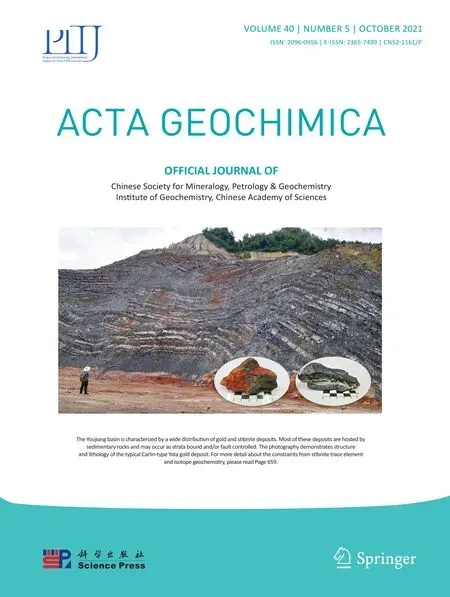Mineralogy and geochemistry of the Ngaoundaba Crater Lake sediments,northern Cameroon:implications for provenance and trace metals status
Armel Zacharie Ekoa Bessa·John S.Armstrong-Altrin·Gentry Calistus Fuh·Thierry Bineli Betsi·Tebogo Kelepile·Paul-De´sire´Ndjigui
Abstract This study was conducted on the Ngaoundaba Crater Lake sediments to infer provenance,weathering conditions,organic matter accumulation,and trace metal concentrations.Ngaoundaba Lake sediments were collected using amanual coresampler at 5 to 8 m water depth.Two sediment cores from the littoral and center of the lake were analyzed for grain size distribution,water content(WC),organic matter content,mineralogy,and major and trace element concentrations.The Ngaoundaba sediments were classified as silt and sandy silt.Sediments show high content in organic matter,which is more to the littoral than to the center of the lake,varying from 14.6%to 24%and 21.2%to 40.8%,respectively.The grain surface features identified by Scanning Electron Microscopy(SEM)show both chemical and mechanical microtextures with subrounded to angular shape suggesting both proximal and distal sources.The lake sediments are composed of quartz,kaolinite,and hematite,with low amounts of feldspars,rutile,calcite,illite,and ilmenite.Weathering indices such as the chemical index of alteration(CIA),chemical index of weathering(CIW),and index of compositional variability (ICV)indicate moderate to intense chemical weathering in the source area and immature to mature sediments.The geochemical composition indicates that the sedimentswere derived from felsic to intermediateigneous rocks,such as granitoids,and maf ic alkali lavas like basanites.The environmental risk assessment of trace metals obtained by enrichment factor(EF)and geo-accumulation index(I-geo)shows low contamination of the lake sediments.
Keywords Ngaoundaba Crater Lake·Mineralogy·Geochemistry·Provenance·Metal traces status
1 Introduction
Crater lake sediments can provide high-resolution records that give valuable information for understanding the provenance,weathering,and environment status.The constant delivery and accumulation of sediments and metals into a lake enable to trace the depositional environment(Lami et al.1996;Tyson 2012).In addition,lake sediments in high-latitude regions are natural recorders of climate and weathering conditions.They preserve physical and chemical conditions,as well as important biological indicators(Nguetsop et al.2013).
Mineralogy and geochemistry of lacustrine sediments are governed by several factors such as source rocks and weathering conditions,hence are reliable indicators of provenance(Tapia-Fernandez et al.2017;Ekoa Bessaet al.2018a;Kuscu et al.2018;Tawf ik et al.2018;Armstrong-Altrin et al.2018,2019;Ngueutchoua et al.2019;Ramos-Va´zquez and Armstrong-Altrin 2019;Rivera-Go´mez et al.2020).Organic matter(OM)and total organic carbon(TOC)in lake sediments concentrate mainly humic substances and other organic compounds(Ramos-Va´zquez et al.2017).Organic matter provides crucial information on the paleoenvironment and the effect of human activity on local and regional ecosystems.The type and degree of alterations of OM during and after incorporation into sediments provide information about the physical and chemical environments of lakes(Meyers and Ishiwatari 1995;Fulvio et al.2020;Akoachere et al.2019).Trace metal contents in recent and ancient sediments are commonly used as a tool to infer the level of contamination of aquatic milieu(Ekoa Bessa et al.2018b;Mandeng et al.2019;Tehna et al.2019).Lacustrine sediments could contain high contents of trace metals,which are considered among the most critical pollutants in natural environments(Wardhani et al.2017;Ekoa Bessa et al.2018a;Armstrong-Altrin et al.2019).
Lake Ngaoundaba is known as maar,which is one of a multitude of other crater lakes that abound in the north of Cameroon and particularly in the Adamawa Region(Temdjim et al.2004).Among these crater lakes,several have been studied by various authors,including Lake Baledjam(Kling 1988),Lake Assom(Ngos et al.2003),Lake Mbalang(Ngos and Giresse 2005;Nguetsop et al.2011;Vincenset al.2010),Lake Tizong(Ngosand Giresse 2012;Nguetsop et al.2013;Lebamba et al.2016),and Fondjak(N’Nanga et al.2019).These authors investigated the sedimentological,pollen,and diatom proxies of the lake sediments and documented the mid-Holocene paleoclimate variations,i.e.,from 7200 to 5000 cal yr BP was the wettest period and from 5000 to 4000 cal yr BP the paleoclimate became dry with an intensif ication of the NE trade wind,Harmattan;from 4000 to 2800 cal yr BP,it waswet again,but forest micro-refugepersisted around the lakeswhen savannah increased;~3000 to 1500 cal yr BP was the driest period;forest biomes disappeared in the Adamawa Plateau and thelake level wasat low-stand from 1500 to 1300 cal yr BP to the Present.However,little attention has been paid to infer provenance and weathering using mineralogical and geochemical parameters of lake sediments.
This study provides a comprehensive major and trace element geochemistry integrated with mineralogy and TOC contents of the Ngaoundaba Crater Lake sediments.The objective of this study is to infer the provenance,weathering,and trace metals status of the Ngaoundaba Lake sediments.
2 Study area
The Ngaoundaba Crater Lake is situated in the northern part of the Adamawa Plateau in northern Cameroon.It extends between latitude 7°07′43′′N-7°08′06′′N and longitude 13°41′26′′E-13°41′47′′E(Fig.1)and iswithin the uplifted Adamawa Volcanic Massif.The study area is bounded to the north and south by large strike slip faults oriented N70°E(Adamawa and Djerem-Mbe´re´faults)and punctuated by numerous crater lakes(Njombie et al.2018;N’nanga et al.2019).It covers 170,000 m2at 1160 m of altitude and has a maximum depth of around 17 m with an average depth of 10 m.The lake area is continuously decreasing due to eutrophication.Swimming and f ishing are taking place in this lake,which is renowned for its tourist attraction.The Ngaoundaba Crater Lake isunder the inf luence of the altitudinal tropical climate showing two distinct seasons:a dry season from November to March and a rainy season,from April to October which corresponds to the northward shift of the Intertropical Convergence Zone(ITCZ).At the level of the ITCZ,the contact between themoist SWmonsoon f low of thelower levelsof the troposphere and the dry NE Harmattan at mid-upper levels entails deep atmospheric convection that is responsible for abundant rainfall.Nevertheless,this position of the ITCZ generates southwards and particularly around the Guinean Gulf atmospheric stability at low levels entailing a stratiform cloud cover,light rain,and drizzle(Nguetsop et al.2013).Conversely,the dry season(November to March),characterized by intense NE trade winds(Harmattan),takes place following the southward displacement of the ITCZ,with an average rainfall maximum of 1401 mm in August.The average annual rainfall is 1555 mm and the average monthly temperaturevaries from 20 to 24°C.Two main rivers(Vina and Marboui)drain through the area with its many small crater lakes that are not fed by these rivers.
The vegetation map of the Adamawa is covered by Sudanese type of woody savanna characterized by two main trees:Daniella oliveri(Caesapiniaceae)andLophira lanceolata(Ochnaceae).Northwards,the height and density of the vegetation drop,gradually giving way to herbaceous savanna.In this area,ferrallitic soils mostly rich in aluminum and iron oxides with frequent neoformation of halloysite and kaolinite are indexed(Ngos and Giresse 2012;Nguetsop et al.2013;Souaidou et al.2015).
The basement rocks of the Adamawa Plateau are composed of crystalline and foliated metamorphic rocks that are covered by three volcanic basaltic f lows of Cretaceous to Quaternary age(Nguetsop et al.2013;N’nanga et al.2019;Ziem a`Bidias et al.2018)(Fig.1b).It is also partially covered by Oligocene to Pleistocene alkaline to peralkaline maf ic lavas(basanites,alkali basalts,and hawaiites)that arealmost completely obscured by soilsand massive stratified phreatomagmatic deposits with more abundant trachyte and phonolite domes and plugs(Temdjim et al.2004;Nkouandou et al.2008;Njombie et al.2018;Tiabou et al.2019).

Fig.1 Location of the Ngaoundaba Crater Lake:a Study area location in Cameroon and Africa;b geological map,c location of the two studied cores
3 Material and methods
Two sediment cores from the Ngaoundaba Crater Lake(Fig.1c)were collected using a manual corer equipped with extension rods attached in a boat.The cores labeled AZ and NL were collected using 50 mm diameter PVC pipes hermetically sealed.Core AZ was sampled near the center of the lake in a water depth of 8 m,with 96 cm of length(Fig.2a).Near the left littoral and eutrophication area,a core 116 cm long labeled NL was sampled at 5 m water depth(Fig.2b).In the laboratory,the cores were opened,photographed,and then sub-sampled for various analyses.The samples were air-dried for two weeks.Subsamples were obtained with a metal spatula at every 10 cm for a total of 20 samples from both cores.The sediment samples were analyzed for their Water Content(WC),particle size distribution,organic matter content,total organic carbon,mineralogy,and geochemistry including major,trace,and rare earth element contents.
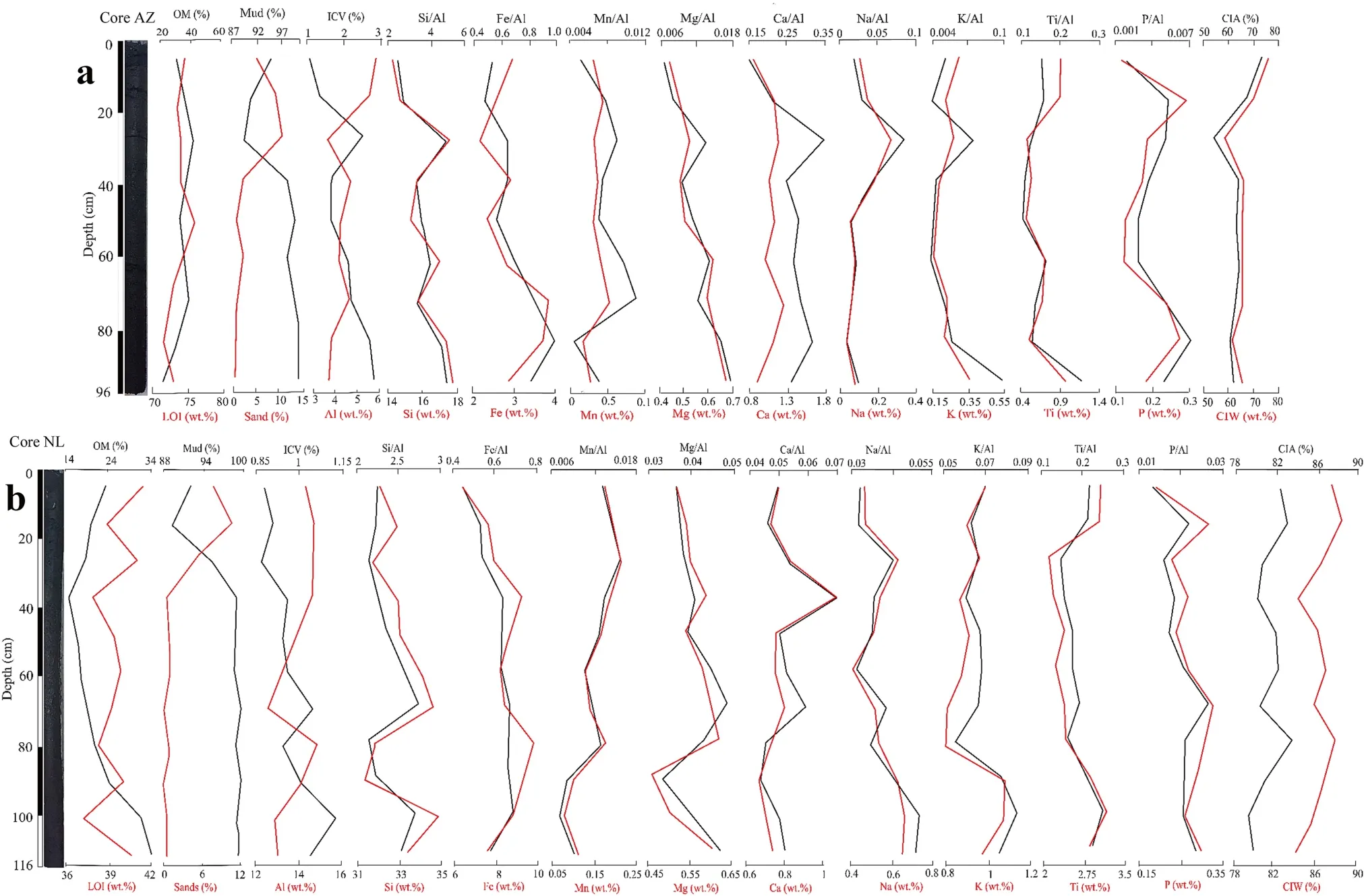
Fig.2 Illustration of core sediment variations in grain size,OM,major element concentrations,Al-normalized ratios,CIA and CIW values of a core AZ and b core NL
3.1 Physical analysis
The WC at 25°C was obtained using the formulae:[(P1-P2)/P1)×100]where P1 and P2 represent the weight of each sample before and after drying,respectively.It was analyzed at the Department of Earth Science(University of Yaounde´I,Cameroon).
Grain size distribution was also performed at the Department of Earth Sciences(University of Yaounde I).Twenty grams of each sample without roots,leaves,and twigs were dispersed into distilled water and grain size distribution wasperformed following thestandard pipetting method.The analytical procedures mentioned by Mbale Ngama et al.(2019)were followed.
3.2 Total organic carbon(TOC)
The total organic carbon was determined using a Primacs SLC analyzer at the laboratories of the International Institute for Tropical Agriculture (IITA; Yaounde´,Cameroon).The Total Carbon(TC)wasf irst determined by combustion at 1100°C.Then,the Inorganic Carbon(IC)was determined at 750°C.Before the analysis,the sample is added to a test tube in which oxygen was purged to remove CO2.To decompose the inorganically bonded carbon to thegaseouscarbon dioxide,orthophosphoric acid was added to the sample.The f low of oxygen purges the carbon dioxide from the liquid into the IR detector to be measured again.The concentration of TOC is determined using the formulae:TOC=TC-IC.Theamount of organic matter(OM)was obtained by the calculation of Walkley and Black(1934)where OM(%)=TOC(%)×1.72.
3.3 Mineralogical and geochemical analysis
The 8 selected samples(4 for each core)were pulverized with agate mortar and pestle for bulk mineralogy and geochemical analysis.Mineral identif ication was done by X-ray diffraction(XRD)using the Rietveld ref inement method(Ufer et al.2008)at Botswana International University of Sciences and Technology(BIUST).It was done using a PAN-Analytical X’PERT PROdiffractometer equipped with Cu-Kαradiation(λ=1.5406 A°)at 40 kV and 45 mA.The semi-quantitative interpretation of XRD minerals was made with the High Scores Plus software.Mineral chemistry was analyzed on selected sample grains after washing and drying using a PHILLIPS XL-30SEM equipped with an energy dispersive spectrometer(EDS)located at UNAM,Mexico.For 20 sediment samples,major and rare earth elements(REE)were quantified at BIUST using XRF and ICP-MS methods,respectively.The Rigaku RIX-3000 wavelength dispersive X-ray f luorescence(XRF)spectrometer was used for major elements after sample ignition.A two-step loss on ignition(LOI)determination was applied:powders were f irst heated at 105°C under nitrogen to drive off adsorbed H2O,before being ignited at 1000°C under oxygen to eliminate the remaining volatile components and oxidize Fe.In this method,powders were melted with a lithium tetraborate f lux prior to analysis by XRF.In addition to the major elements,trace metalswere analyzed from sample powders using the Inductively Coupled Plasma Optical Emission Spectrometry(ICP-OES)technique.Acid digestion was employed in closed beakers using Burnham and Schweyer’s(2004)approach with a Perkin Elmer 9000 instrument.
3.4 Trace metal concentrations in sediments
Trace metal distribution(Fe,Mn,Cr,Cu,Pb,and Zn)in twenty sediment samples from selected core intervals were digested using amixtureof HCl:HNO3(3:1)at 80°Cin an Agilent 4200 Microwave Plasma-Atomic Emission Spectrometer(MP-AES)at University of Botswana(UB),BIUST.Thedigested samplesolutionswereanalyzed using ICP-OES 3000 XL(Perkin Elmer).The detection limits range from 0.05×10-3to 4.0×10-3ppm depending on the element.The quality assurance and quality control of analysis were assessed by EPA standard using duplicates,standard reference materials,and blanks.
3.5 Trace metal pollution indices
The enrichment factor(EF)is a commonly used index to discriminate natural and anthropogenic sources of sediments,which can be calculated by the formula proposed by Salati and Moore(2010):

where[M]sample/[Fe]sampleis the sample concentration(mg/kg)of metal and iron in sediment sample and[M]Background/[Fe]Backgroundrefers to the background value of the metal and iron(Turekian and Wedepohl 1961).We considered iron(Fe)in this study,as the reference element for geochemical normalization because of the following reasons:(i)Fe is associated with f ine solid surfaces;(ii)its geochemistry is similar to that of many trace metals and(iii)its natural concentration tends to be uniform(Bhuiyan et al.2010).
The geo accumulation index(I-geo)is another method to evaluate the level of pollution,which relies on the trace metal concentration in sediments.I-geo can be calculated using the following formulae(Muller 1969):

Cnis the content(mg/kg)of metal in the sample;Bnis the chemical background concentration(mg/kg)of the element in the background sample and factor1.5is initiated to reduce the effects of probable dissimilarities in the background values,which may be linked to the lithogenic effects.The trace metal indices were deduced using the background data from Turekian and Wedepohl(1961).
4 Results
4.1 Physical features and Total Organic Carbon(TOC)
Physical features(including water content,grain size distribution,and texture)and TOC associated with organic matter are listed in Table 1.The central core(AZ)exhibits a blackish silty mud layer of 60 cm thick,overlain by 36 cm thick muddy and debris ash layers.For the littoral core(NL),the blackish silty mud layer is about 40 cm in thickness,and the debris ash layer 76 cm thick.Water content in the lake sediments varies from~60%to~72%,and thehigh valuesareobserved in thetop section of the cores.The particle size indicates that the f ine fraction was dominated by mud (silt and clay)(89.4vol.%-99.3vol.%)and the remaining is occupied by sand(0.7vol.%-10.6vol.%).The texture of the bottom section of the AZ core is clayey silt(f irst 60 cm)and the top is silty.Then the NL core bottom section(f irst 40 cm)is sandy silt with silt type in the remaining core sediments(Fig.SM1).
The TOC is used to infer the organic matter content in sediments.In both cores,AZ and NL,the concentrationsof TOC vary from 12.3%to 23.7%and 8.5%to 19.9%,respectively(Table 1).It corresponds to the high content of organic matter in the sediments.The organic matter content is higher in core AZ(~21.2%-40.8%)than in core NL(~14.6%-24%).
4.2 Quartz grain microtextures
To get the detailed information regarding the origin and transport medium,the microtextures on quartz grain surfaces were examined by scanning electron microscopy(SEM)(Whalley and Krinsley 1974;Hossain et al.2020;Armstrong-Altrin 2020;Ramos-va´zquez and Armstrong-Altrin 2020).Core AZ sand grains are mostly sub-rounded(Fig.3a-c),whereas grains from NL core vary from subangular to angular(Fig.3g-I).
The microtextures on quartz grain surfaces from different sections showed both mechanical and chemical features(Fig.3d-l).Microtextures due to mechanical origin include fresh surfaces,abrasive surfaces,striations,conchoidal fractures,straight steps,and V-shaped pits.Most of the sand grains showed various types of chemical features,such as scaling,pre-weathered surface,dissolution pits,and vesicular shards.Adhering particles located within pits and other collision impact regions on the sand grain surfacesare classified asmechanical/chemical origin.
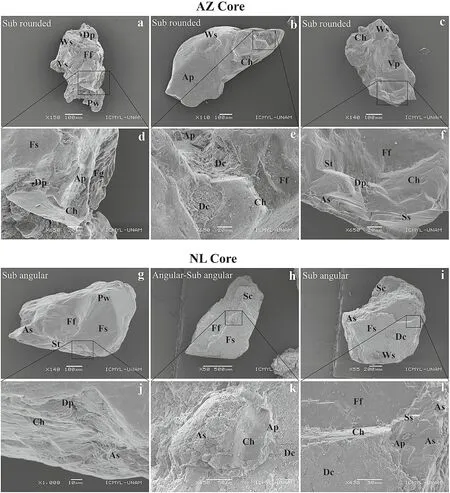
Fig.3 SEM images of quartz grain surface microtextures and morphology from the Ngaoundaba Crater Lake:a-f sub-rounded shapes and surface grains of core AZ and g-l sub-angular to angular shapes and surface grains of core NL(As:abrasive surface;Fs:fracture surface;St:striation;Pw:preweathering;Sc:scaling;Dc:dissolution crust;Ws:weathering surface;Dp:dissolution pit;Ch:conchoidal fracture;Ap:adhered particle;Ss:straight step;Vs:vesicular shards;Vp:V-shaped pit;Fg:f linty globules)
4.3 Mineralogy
The mineralogy of Ngaoundaba Lake sediments is shown in Fig.4.Almost all sediment samples from different intervals are similar in terms of mineralogical compositions.The sediments are mainly composed of quartz,kaolinite,and hematite,with minor amounts of plagioclase feldspars,rutile,and calcite.Illite and ilmenite are present as traces.SEM/EDS images also conf irm these mineral assemblages.
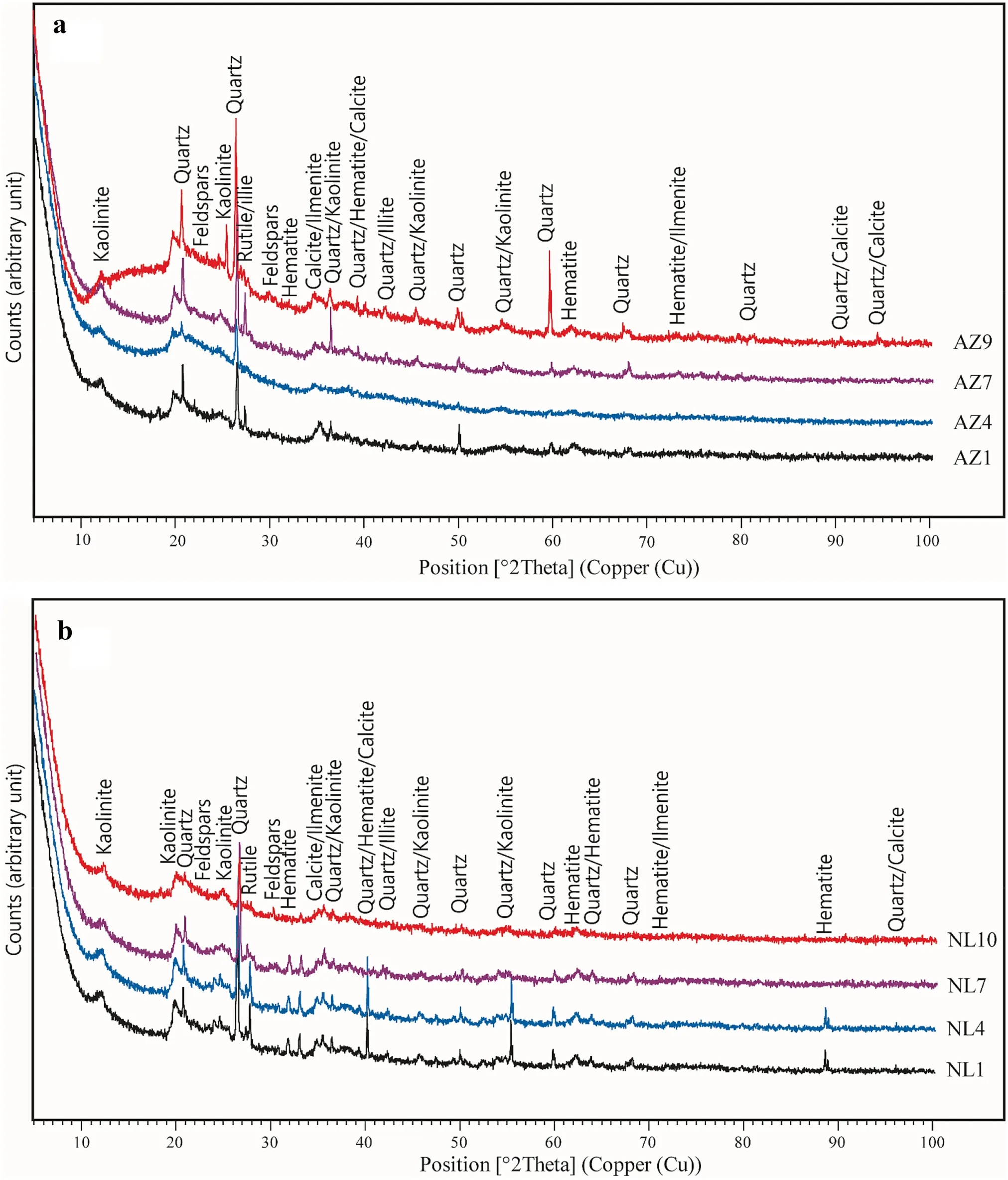
Fig.4 X-ray diffraction patterns for sediments from Ngaoundaba Crater Lake:a core AZ and b core NL
SEM-EDS analysis showed that the Ngaoundaba Lake sediments are composed of oxides of silica,alumina,chromium,iron,phosphorous,titanium,calcium,magnesium,manganese,and potassium,with high contents of silica,alumina,and iron.Thepresenceof ilmenitemight be conf irmed by the high proportion of TiO2and FeO in aggregates(Fig.5a).Likewise,the high content of SiO2,Al2O3,and FeO in some grains conf irms the presence of kaolinite(Fig.5a).A very signif icant fraction of the asreceived ilmenite concentrate appeared to be TiO2(rutile;Fig.5b),which remained as TiO2.A very high content of FeO refers to hematite(Fig.5a).Illite is mainly composed of SiO2,Al2O3,and K2O(Fig.5b).The presence of Al2O3and SiO2are in high abundance and CaO and Na2O are in moderate abundance.The low abundance of FeO,MgO,and K2O contents indicates the presence of plagioclase feldspar(Fig.5b).

Fig.5 Scanning electron microscope and SEM-EDSspectrum for grains from the Ngaoundaba Lake:a core AZ with(1)ilmenite;(2)kaolinite;(3)hematite and(4)rutile;b core NL with(1)illite;(2)feldspars and(3)rutile
4.4 Geochemistry
4.4.1 Major oxides
Concentrations of major elements in the Ngaoundaba Crater Lake sediments(core AZ;n=9 and core NL;n=11)are listed in Table 1.The concentration of SiO2varies from 14.23 wt.%to 17.59 wt.%in AZ and from 31.32 wt.%to 33.97 wt.%in NL sediments.Al2O3concentration in AZ varies from 3.65 wt.%to 5.97 wt.%.In core NL,Al2O3varies from 12.54 wt.%to 14.86 wt.%.Fe2O3concentration varies from 2.33 wt.%to 3.98 wt.%in AZ core sediments.Fe2O3is high in NL core sediments and varies from 6.45 wt.%to 9.78 wt.%.The TiO2concentration is higher in NL than in core AZ,ranging from 2.14 wt.%to 3.21 wt.%and<1 wt.%,respectively.The remaining elements have concentrations<1 wt.% in almost all core intervals.In addition,very high values of losson ignition(LOI)are observed in thecore sediments.It varies from 70.90 wt.%to 75.30 wt.%in core AZ sediments and from 36.90 wt.%to 40.40 wt.%in the NL core sediments.The high LOIvalues as a result of high volatile losses are due to the high contents of organic matter in these sediments.
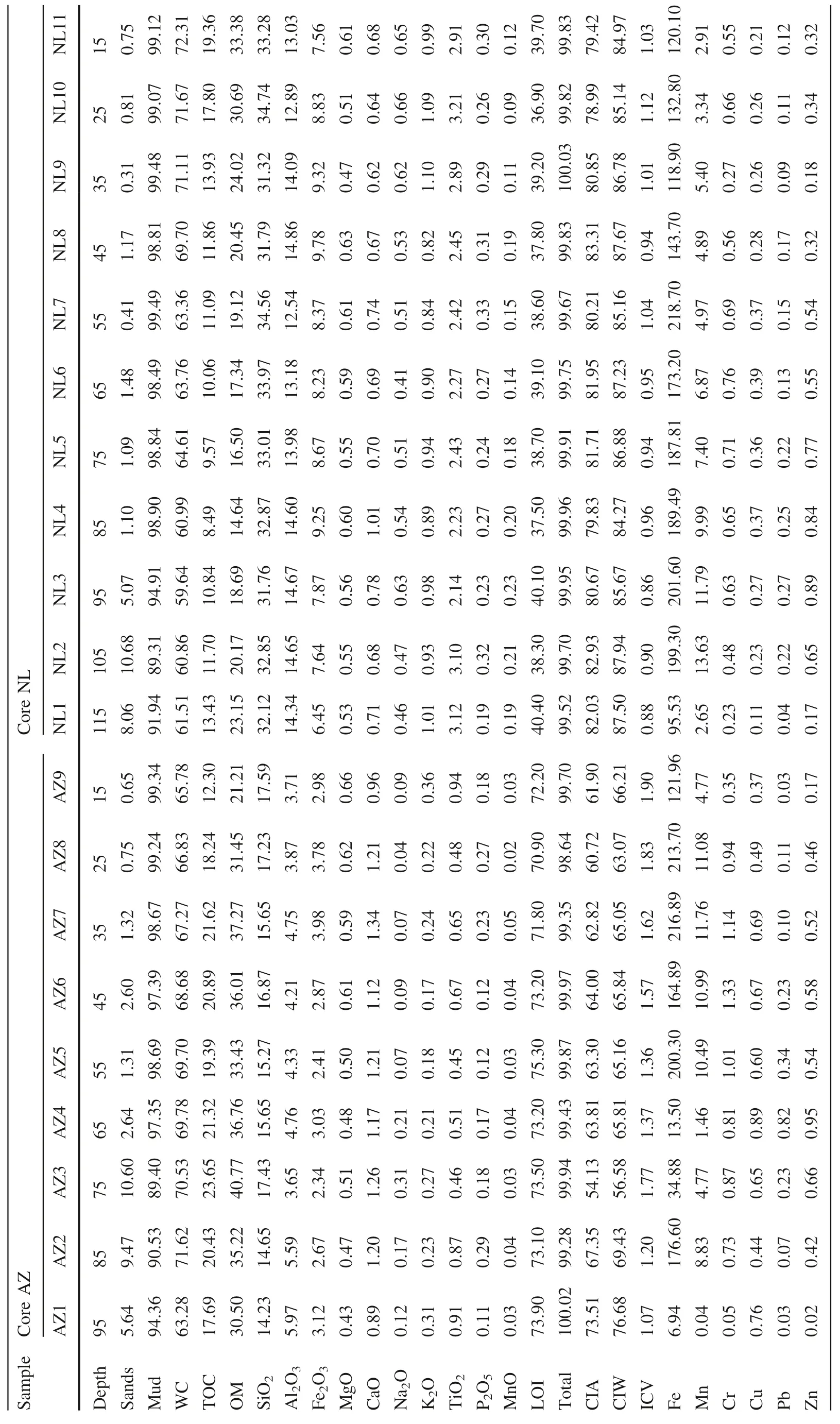
Table 1 Sampling depth (cm), sediment characteristics in % (grain size, water content (WC), total organic carbon (TOC), organic matter (OM)), elements oxides (wt.%) with indices (%) and heavy metal concentrations (mg/kg) of Ngaoundaba Lake sediments
4.4.2 Normalization of major elements
The depth prof iles for major element concentrations normalized by Al are shown in Fig.2.The average concentrations are in the following order:Si>Al>Fe>Ca>Ti>Mg>K>P>Na>Mn in core AZ and Si>Al>Fe>Ti>K>Ca>Mg>Na>P>Mn in core NL sediments.Ca,Mn,P and Fe concentrations normalized by Al show signif icant f luctuations,while Si/Al,Mg/Al,Na/Al,K/Al and Ti/Al ratios are relatively stable in AZ core sediments.However,Al-normalized ratios of Si,Fe,Ti and Pshow moderate variation in the NL core sediments.
4.4.3 Weathering indices
In this study,numerous weathering indices have been used to determine the weathering conditions in the source area(Table 1;Fig.2),which include a chemical index of alteration (CIA=[Al2O3/(Al2O3+CaO*+Na2-O+K2O)]×100,suggested by Nesbitt and Young(1982);chemical index of weathering(CIW=[Al2O3/(Al2O3+CaO*+Na2O)]×100),proposed by Harnois(1988), and index of compositional variability(ICV=Fe2O3+K2O+Na2O+CaO+MgO+TiO2)/Al2O3;Cox et al.(1995),which has been successfully used by many authors to measure the compositional maturity.For sediments,ICV>1 are compositionally immature and ICV<1,suggests compositionally mature sediments(Cox et al.1995).For CIA and CIW calculations,molar contents are used and CaO*is the CaO molar content in the silicate fraction of the sample.CaO molar content is accepted as CaO*if CaOmolar content islessthan that of Na2O when CaO molar content is greater than that of Na2O,CaO*equals Na2O molar content(McLennan et al.1993).CIA and CIW values near 50 indicate no weathering,values varying between 60 and 80 are suggestive of moderate weathering,and values>80 indicate high intensity of chemical weathering(Nesbitt and Young 1982;Harnois 1988).The CIA values vary from 54.1 to 73.5 and 79 to 83.3 in AZ and NL cores,respectively.The same trend is observed in CIW,which rangesfrom 56.6 to 76.7 and 84.3to 88 in AZ and NL,respectively.Ngaoundaba Crater Lake sediments have almost similar ICV values,which vary between 1.07 and 1.90 in AZ and 0.86 and 1.12 in NL core sediments.
4.4.4 Rare earth elements(REE)
The total REE contents vary between 83 and 100 ppm in AZ and between 254.84 and 292.33 ppm for NL core sediments(Table 2).The REE concentrations are normalized against the average chondrite values of McDonough and Sun(1995).The chondrite-normalized REE values show moderate to high fractionation as seen by(Gd/Yb)Nratios,which vary from 1.19 to 3.95.Contrary to other lake deposits in the sub-region(e.g.Ekoa Bessa et al.2018a;N’nanga et al.2019),the sediments from Ngaoundaba Lake are enriched in light REE(LREE)with respect to heavy REE(HREE;LREE/HREE~9.01-12.23).LREE enrichments are also evident by high(La/Sm)Nand(La/Yb)Nratios,ranging from 3.33 to 4.95 and 6.54 to 20.38,respectively.Amongst REE,Ce is the most abundant element in the core sediments.In core AZ,Ce values range between 35.9 and 45.7 ppm,and in NL core they vary from 108.5 to 143.8 ppm(Table 2).Cerium is followed by lanthanum and neodymium,and thelowest concentration is obtained for lutetium(Table 2).The Ngaoundaba sediments show positive and negative Ce anomalies,varying from 0.83 to 1.30.The Eu valuesrangefrom 0.24 to 1.16 in the core sediments.
4.5 Trace metal distribution
The vertical distribution of trace metals in ppm from the AZ and NL core sediments are listed in Table 1.The mean concentrations(in ppm)of selected trace metals are as follows: Fe (6.94-200.30)>Mn (0.04-13.63)>Cr(0.05-1.33)>Zn (0.02-0.95)>Cu (0.11-0.89)>Pb(0.03-0.82).Trace metal concentrations are lower than the background values of Turekian and Wedepohl(1961).
4.5.1 Enrichment factor(EF)
The EF values are grouped into f ive different categories:EF≤2 characteristic of absence or minimal enrichment;2<EF≤5 moderate enrichment;5<EF≤20 with signif icant enrichment;20<EF≤40 represent very high enrichment and EF>40 characteristics of extremely high enrichment(Loska et al.1997).Statistical variations of EF are reported in Table 4,which reveal minimal to moderate enrichment(1<EF<5)except for samples NL1,NL3,and NL4 from the NL core located in the littoral.Enrichment factor for the trace metals includes Mn,Cr,Cu,Pb,and Zn in sample NL3 varies from 7.59 to 19.69.This is related to the signif icant enrichment of trace metals in the NL3 sample.The same trend can be recognized in NL4,except for Cu and Pb,with EF>40 related to extremely high enrichment.This extremely high enrichment is also identified for Cu in the NL1 sample(Table 3).
4.5.2 Geo-accumulation index(I-geo)
TheI-geocan be grouped into six classes,which are representative of sediment quality.They are:I-geo<0(0;unpolluted),0<I-geo≤1(1;unpolluted to moderately polluted),1<I-geo≤2(2;moderately polluted),2<Igeo≤3(3;moderately to strongly polluted),3<I-geo≤4(4;strongly polluted)and 4<I-geo≤5(5;strongly to extremely polluted).The geo-accumulation index of the selected trace metals falls in class 0 withI-geo<0demonstrating that the NL and AZ sediments are not polluted(Table 3).
4.6 Statistical analysis
The geochemical processes that occurred in the Ngaoundaba Lake sediments can be better understood using multiparameter statistical techniques.In this study,Pearson correlation matrix and cluster analysis were applied to explain the variance and correlation among chemical elements,grain sizes,and OM.The Pearson correlation matrix in Table 3 obtained for the lake sediments shows both signif icant positive and negative correlations.The results show strong positive correlations among almost all major elements,except negative correlation with CaO.The high positive correlations between major elements are observed for SiO2,Al2O3,and Fe2O3with other major elements.A signif icant positive correlation of Al2O3with few major oxides can be indicative of a detrital source,whereas a signif icant positive correlation of Fe2O3with most of the major oxides can indicate an allochthonous provenance.Strong positive correlations are also observed for OM with CaO(r=0.68;P<0.05),LOI(r=0.74;P<0.05)and Cr(r=0.64;P<0.05).On the other hand,strong negative correlations were observed for LOI with most selected parameters except OM and CaO withr=0.74 andr=0.87,respectively withP<0.05.It supports the assumption that CaO is largely derived from carbonate(e.g.calcite).This indicates that the production of OM and CaO may be governed by the same factors and LOI is a good indicator of OM content.Sand has a perfect negative correlation with mud,but both of them do not have a signif icant correlation with selected elements and OM(Table 4).CaO shows a negative correlation with all other oxides indicating that Ca is not inf luenced signif icantly by detrital sources(e.g.feldspars).Both signif icant positive and negative correlations of trace metals(Fe,Mn,Cr,Cu,Pb,and Zn)with each other in the lacustrine sediments indicate anthropogenic and natural inputs.

Table 2 Trace element concentrations (in ppm) in the Ngaoundaba Crater Lake sediments

Table 3 continued

Table 3 Pearson correlation matrix for understanding the sediment quality parameters of the Ngaoundaba Crater lake
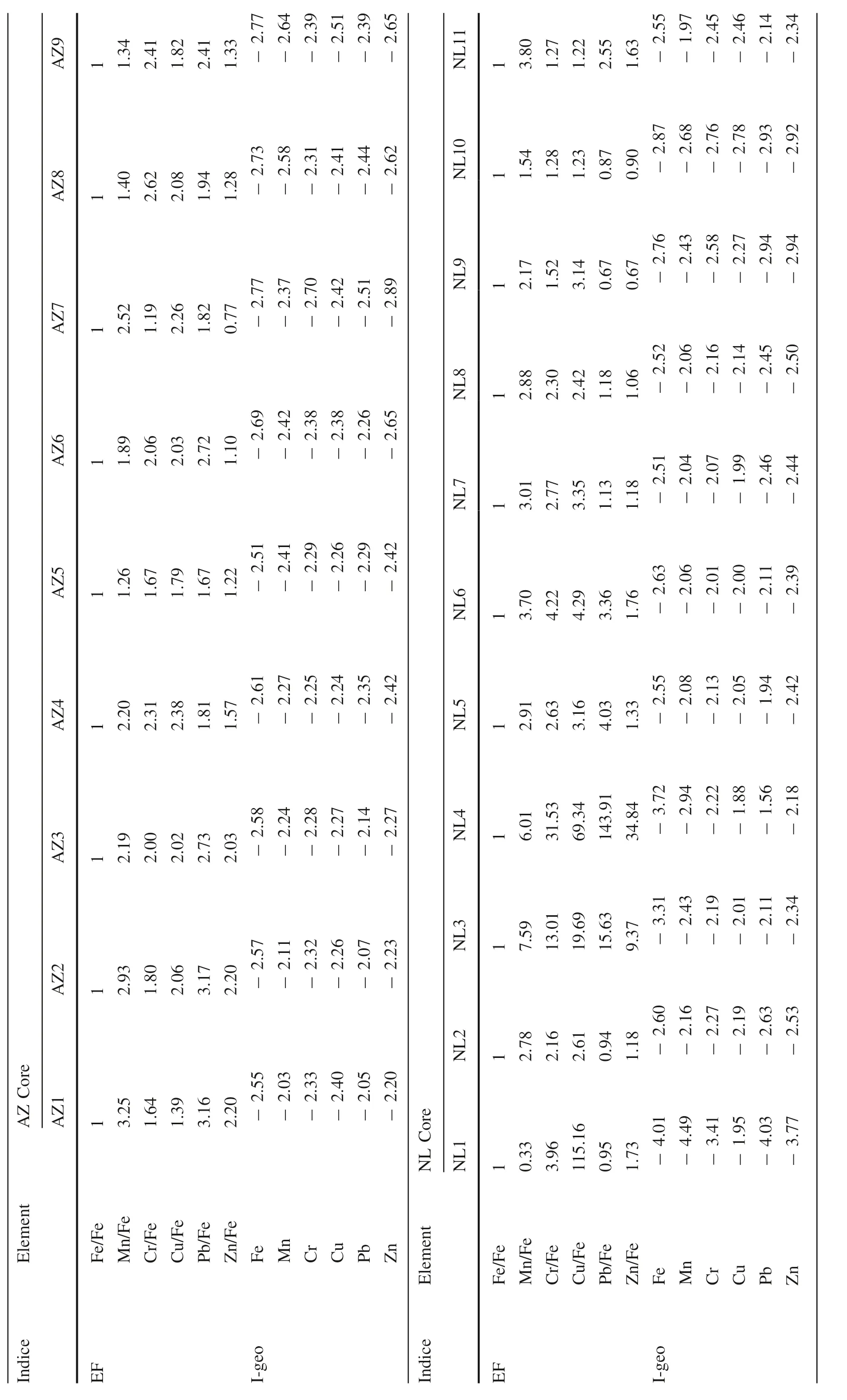
Table 4 Enrichment Factor (EF; Wedepohl 1995) and Geo-accumulation Index (I-geo; Muller 1969) for the Ngaoundaba Crater Lake sediments, calculated based on the background values(Turekian and Wedepohl 1961)
The application of principal component analysis(PCA)to the major and selected trace element data provided two main components(PC1 and PC2)that explain 68.22%of the total variance for Ngaoundaba Lake sediments(Fig.6).PC1 explaining about 52.02%and show a positive loading almost for all trace metals(Cu Pb,Cr,Mn,Zn)and CaOin opposition to Al2O3,TiO2,Na2O,and K2O,suggesting that these elements tend to be incorporated by minerals such as calcite(Fig.6).In these sediments,PC2 of about 16.20%show a negative loading for sands,OM,and LOIopposing to SiO2,MgO,MnO,P2O5,Fe,and Mud,ref lecting the differentiation between sand and mud,and between element oxides and OM-rich sediments.
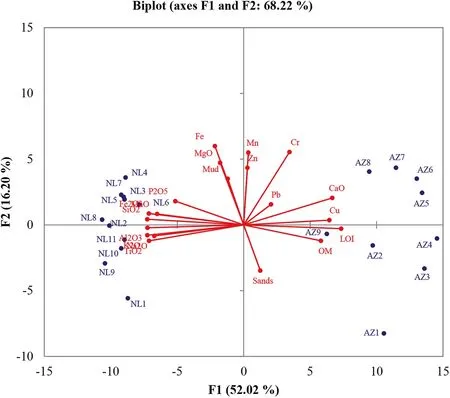
Fig.6 PCA correlation biplot for the parameters measured in the Ngaoundaba Crater Lake sediments
Similarly,cluster analysis is applied to verify similaritiesbetween physical and chemical parameters.Groupsand similarities of different parameters are shown in the dendrogram(Fig.7).The dendrogram indicates two major groups for the studied parameters.Group 1 reveals that grain size has a positive correlation with Pb,Zn,OM,Cu,CaO,and LOI.Within thisgroup,two subgroups are linked to sand,f irst with a strong correlation between Pb and Zn and the other among OM,Cu,CaO,and LOI,where CaO and LOIhave themost similarity.However,group 2 of this dendrogram shows 2 subgroups with low negative correlation.The f irst subgroup includes the major oxides except for MgO and CaO,with a strong positive correlation between each other.Thesecond subgroup consistsof MgO,mud,Mn,Fe,and Cr where mud signif icantly correlated with MgO and also Cr with Fe and Mg(Fig.7).

Fig.7 Dendrogram for the parameters measured in the Ngaoundaba Crater Lake sediments
5 Discussion
5.1 Sediment characteristics
Textural class reveals that the sediments are mostly silty and few samples from the bottom section are clayey silt in AZ.The f ine fraction isdominant in the AZ center coredue to the depth.The predominance of clay and silt fractions in the Ngaoundaba Lake sediments is due to the low and/or absence of drainage f low towards the lake.Thef ine-grained size distribution is conf irmed by the geochemical classif ication diagram of Herron(1988),where almost all sediments fall into Fe-shale f ield,except two samples which plot on Fe-sand f ield(Fig.SM2).The sub-rounded grains are linked to long transport.
Surface microtextures on sand grains are related to mechanical and chemical processes during transport and deposition.The mechanical features include fresh surfaces,abrasive surfaces,striations,conchoidal fractures,straight steps,and v-shaped pits.The abrasive surfaces and conchoidal fractureson thesub-rounded edgesref lect sustained high shear stress.A straight step is generally characteristic of a tectonic origin and can be related to fault systems(Mahaney 2002).The latter coated by quartz and clay minerals,it is clear that a signif icant population of samples is reworked,possibly sourced from a warm and humid climate.Fluvial action produces collisions between grains,resulting in v-shaped pits,which are due to deposition in a high energetic subaqueous environment like the hillside of the Ngaoundaba Crater(e.g.Mahaney et al.1988).Quartz grain presents solution pits,vesicular shards,weathered surfaces,scaling and dissolution pits,which are chemical weathering products of source rocks during contact with external factors,probably liberated at the time when source rocks were exposed to the atmosphere(Ramos-Va´zquez and Armstrong-Altrin 2020).Among chemical microtextures some grains show fresh surfaces,indicating a preweathering history,followed by local f luvial transport to the lake(Fig.3).
5.2 Provenance signatures
The major element concentrations in sediments largely depend on the nature of their source rocks and are extensively used to investigate the source and provenance of sediments.The provenance discrimination diagram of Roser and Korsch(1986)is widely used in various studies to infer sediment provenance(Herna´ndez-Hinojosa et al.2018;Ramos-Va´zquez et al.2018;Madhavaraju et al.2020;Udayanapillai et al.2020).On this provenance discrimination diagram,the AZ core lake sediments mostly plot in the quartzose sedimentary provenance f ield.However,sediments from the core NL plot in the felsic and intermediate igneous provenance f ields(Fig.8).The felsic and intermediate provenances may be linked to pre-Pan-African granitoids,volcanic rocks,and maf ic lavas around the Crater Lake.This indicates that the samples are derived from a variety of source rocks(mixed provenance).These rocks were exposed by the orogenic uplift of the Adamawa and Djerem-Mbe´re´faults from the surrounding area.The lake sediments were deposited by a longitudinal transport parallel to the orogenic grain prior to f inal crustal collision along the Adamawa and Djerem-Mbe´re´faults in a passive margin(Graham et al.1975).

Fig.8 Discriminant function(F)diagram after Roser and Korsch(1986),where F1=(-1.773×TiO2)+(0.607×Al2O3)+(0.76×Fe2O3)+(-1.5×MgO)+(0.616×CaO)+(0.509×Na2O)+(-1.22×K2O)+(-9.09) and F2=(0.445×TiO2)+(0.07×Al2O3)+(-0.25×Fe2O3)+(-1.142×MgO)+(0.438×CaO)+(1.475×Na2O)+(1.426×K2O)+(-6.861)
According to Cullers and Graf(1984)high LREE/HREE ratios and negative Eu anomalies are linked to felsic rocks,whereaslow LREE/HREEratioswithout any Eu anomalies indicate maf ic source rocks.The absence of Eu anomalies in core sediments indicates that they were originated from undifferentiated to slightly differentiated maf ic provenance such as basalt and their products(Table 2;McLennan et al.1993).The felsic contribution is also conf irmed by the high LREE/HREE ratios in NL core sediments.
5.3 Weathering conditions
Mineralogy and geochemical indices can help to determine the weathering conditions(Armstrong-Altrin et al.2020).Recycling of sediments during transport leads to decrease feldspar content.Iron is sensitive to redox conditions in aquatic environments.Mineralogy of Ngaoundaba Crater Lake sediments revealed the presence of clay minerals and high content of iron oxide coatings,which may result from diagenetic processes or from intense weathering in the source areas.The presence of kaolinite and illite suggests chemical weathering of feldspars,which are mineral phases,derived from the granitic and gneissic source rocks.
Moreover,chemical indices such as CIA(Chemical Index of Alteration)and CIW (Chemical Index of Weathering)values are well correlated in both core sediments(Fig.2).The good correlations suggest that these indices of weathering,despite their different methods of assessment,can be signif icantly inf luenced by the size of the sand grains(Sun et al.2018).Thevariation of chemical indices values of the core sediments is attributed to the variation in the intensity of weathering in the source rocks.Based on the ICV values and the ICV versus CIA diagram,it is inferred that the sediments from the center of the lake(AZ)are immature and moderately weathered;whereas,sediments from the littoral(NL)are mature and intensively weathered(Fig.9).This can ref lect the variability of the oxidizing conditions in the lake,from the littoral to the center.
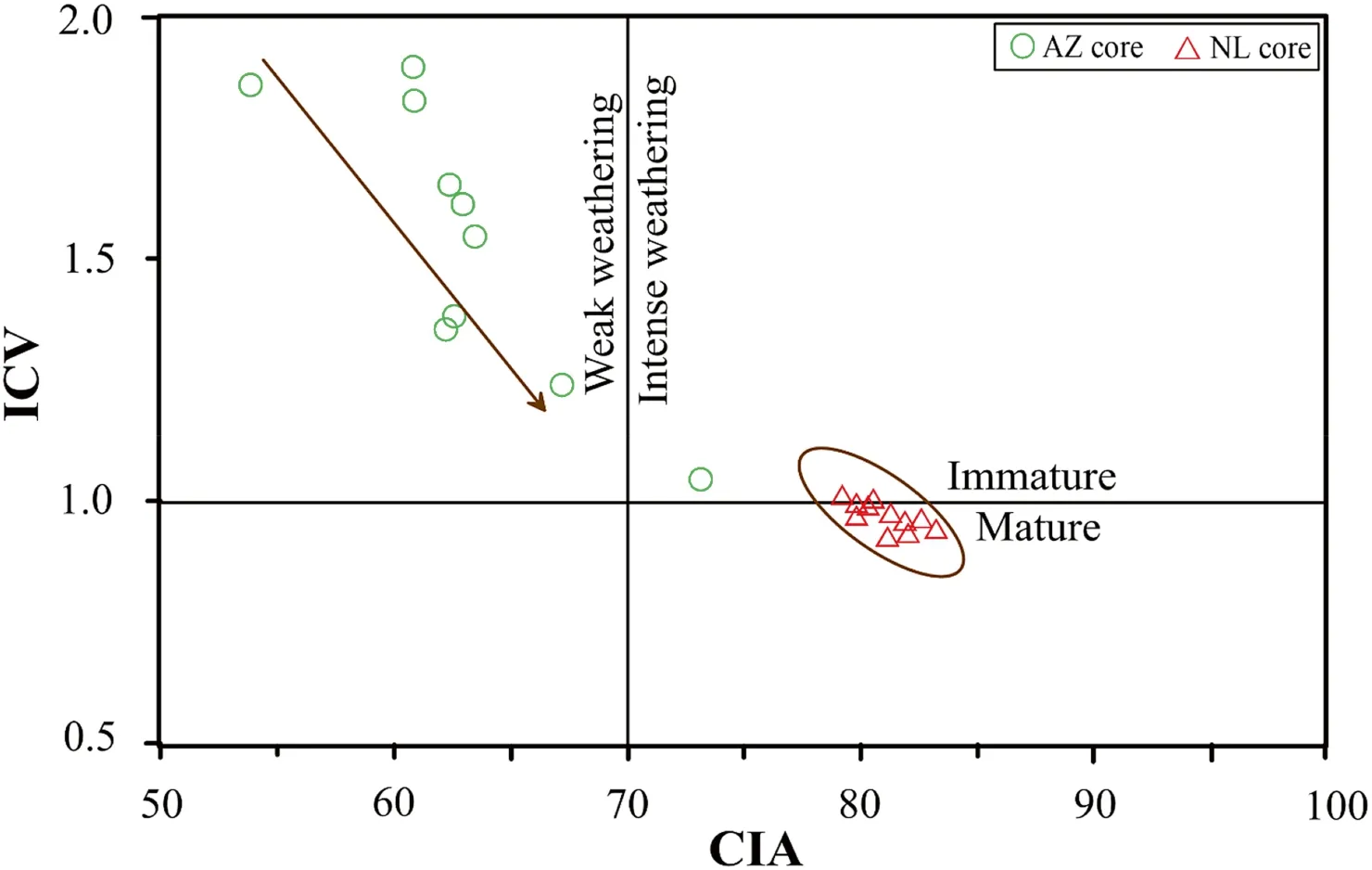
Fig.9 ICV versus CIA diagram(Nesbitt and Young 1984;Cox et al.1995)of the Ngaoundaba Lake sediments
5.4 Inf luence of organic matter accumulation
The accumulation of organic matter in core sediments is obtained by the TOC content.The Ngaoundaba Crater Lake has littoral vegetation which can increase the accumulation of organic matter in sediments.Production of organic matter in lacustrine sediments can be related to the supply of biologically essential elementsas P.The Pvalues vary from 0.11 to 0.33%with higher content in the littoral core(NL)than center core(AZ).P/Ti ratios in this study vary from 0.06 to 0.14 and 0.12 to 0.39 in the center(AZ)and littoral(NL)cores respectively,suggesting that the lake was productive in the past.Titanium and Si can also be used as detrital f lux indicators(Tribovillard et al.1994;Anaya-Gregorio et al.2018).TiO2and SiO2show higher contents in the littoral than in the center of the lake,indicating more detrital input in the lake littoral.This reveals that land-based input may increase organic matter accumulation.Al-normalized Si,Ti,Ca,and Pcan also provide useful information about changes in detrital f lux.Therefore,detrital f lowscannot be neglected in their inf luence on the enrichment of organic matter.High organic matter content in the center and littoral lake areas indicates favorable local conditions for OM enrichment like warm and humid climate conditionsasconf irmed by geochemical indices.This can promote stratif ication,eutrophic,and nutrient-rich surface waters produced by episodes of basin eutrophication and algal blooms(Zeng et al.2015;Sun et al.2018).Moreover,a relatively weakly turbulent and O2-depleted environment due to the burial of algae increased the conservation of organic matter.
5.5 Trace metal status
Environmental indices(EF andI-geo)coupled with statistical methods were used to assess the trace metal status of the lake ecosystem.Trace metals in the lacustrine milieu are known to be related to the human effects and sometimes with the weathering input from source rocks(Ekoa Bessa et al.2018a).In this study,the environmental risk assessment of trace metals suggests low contamination(Table 3).The lake sediments from Ngaoundaba show the heterogeneous origin of OM including in situ and terrestrial.This suggests the contribution from both anthropogenic and natural sources.In the study area,there are no major industries.Tourism,artisanal f ishing,and agriculture are the major potential sources for the increase in trace metal pollution in the lake sediments by the dumping of plastic,liquid wastes,and the use of pesticides.The ecological risk and lake system changes occur with time along the lake catchments,which can be responsible for the lake deteriorating,erosion,and other earth surface processes in and around the lake(Badar et al.2013).
6 Conclusions
1. The Ngaoundaba Crater Lake sediments are texturally classified as sand and mud and geochemically are classified as Fe-clay and Fe-sand.The sediments are composed of quartz,kaolinite,hematite,feldspar,rutile,and calcite and associated with illite and ilmenite.
2. The SEM and geochemical data reveal that the sediments were derived from felsic and intermediate igneous rocks such as granitoids,volcanic rocks,and maf ic lavas.The results of this study further revealed that the sediments in the center portion of the lake are immature and littoral are mature.
3. The production of organic matter in lacustrine sediments can be related to the supply of biologically essential elements such as phosphate.However,higher contents of TiO2and SiO2in the lake sediments indicate more detrital input and land-based input.
4. The sediments are moderately to intensively weathered.Thesesedimentsweredeposited by alongitudinal transport parallel to the orogenic grain prior to f inal crustal collision along the Adamawa and Djerem-Mbe´re´faults in a passive margin.
5. The environmental risk assessment of trace metals suggests low contamination of lake sediments,which is attributed to the little inf luence of tourism,artisanal f ishing,and geology of the surrounding area.
AcknowledgementsThe f irst author thanks the crew of the Botswana International University of Sciences and Technology(BIUST)for their assistancein dataacquisitions,interpretations,and laboratory equipment.He also thanks to the African-German Network of Excellence in Science(AGNES)for granting a Mobility Grant in 2019.The Grant was generously sponsored by the German Federal Ministry of Education and Research and supported by the Alexander von Humboldt Foundation.We are indebted to the anonymous reviewers and Dr.Elisabeth B.Rampe for their comments,discussions,and suggestions on the manuscript,which signif icantly improved our presentation.
Declarations
Conf lict of interestOn behalf of all authors,the corresponding author states that there is no conf lict of interest.
- Acta Geochimica的其它文章
- Correction to:Variations of methane stable isotopic values from an Alpine peatland on the eastern Qinghai-Tibetan Plateau
- Bicarbonate use and carbon dioxide concentrating mechanisms in photosynthetic organisms
- The possible source of uranium mineralization in felsic volcanic rocks,Eastern Desert,Egypt of the Arabian-Nubian Shield:Constraints from whole-rock geochemistry and spectrometric prospection
- Dissolved organic carbon concentration and its seasonal variation in the Huguangyan Maar Lake of Southern China
- Geochemistry and provenance of the lower-middle pliocene cheleken formation,Iran
- Geochemistry,geochronology,and zircon Hf isotopic compositions of felsite porphyry in Xiangshan uranium oref ield and its geological implication

